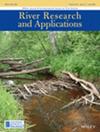温带溪流的环境 DNA 时间序列分析揭示了独特的季节性群落和功能变化
IF 1.9
4区 环境科学与生态学
Q4 ENVIRONMENTAL SCIENCES
引用次数: 0
摘要
从水中提取的环境 DNA(eDNA)被常规用于河流生物多样性研究,通过代谢标定,eDNA 可以提供全面的分类群列表,而不需要花费太多的精力和成本。然而,基于 eDNA 的溪流和河流物种检测可能会受到采样季节以及水温和排水量等其他关键因素的影响。目前还缺少将这些因素联系起来的研究,也缺少关于 eDNA 代谢标码检测生态特征(如物种物候和功能性摄食群体)在不同季节变化的潜力的研究。为了弥补这一空白,我们在一个长期生态研究(LTER)地点,在河流横断面的三个不同位置,特别是水面、河床和河岸,每两周采集一次水样,连续采集了 15 个月。对于这 102 个样本,我们根据细胞色素 c 氧化酶亚单位 I(COI)代谢编码数据,分析了大型无脊椎动物的物种和分子操作分类单元(OTU)丰富度以及不同季节的时间群落更替。利用广义加性模型,我们发现采样季节对物种丰富度有显著影响。群落更替遵循一种循环模式,反映了大型无脊椎动物群落在一年中的持续变化("季节钟")。虽然水温对推断的物种丰富度没有影响,但较高的排水量减少了用 eDNA 检测到的蛛形纲和蜉蝣纲物种数量。大多数大型无脊椎动物类群在春季的物种丰富度最高,尤其是具有单伏生命周期的子午线物种。此外,我们还发现冬季碎屑类和夏季寄生类的比例有所增加。我们的研究结果表明,高分辨率的 eDNA 代谢编码时间序列数据对溪流和河流的生态研究和生物多样性监测非常有用。本文章由计算机程序翻译,如有差异,请以英文原文为准。
Environmental DNA time series analysis of a temperate stream reveals distinct seasonal community and functional shifts
Environmental DNA (eDNA) extracted from water is routinely used in river biodiversity research, and via metabarcoding eDNA can provide comprehensive taxa lists with little effort and cost. However, eDNA-based species detection in streams and rivers may be influenced by sampling season and other key factors such as water temperature and discharge. Research linking these factors and also informing on the potential of eDNA metabarcoding to detect shifts in ecological signatures, such as species phenology and functional feeding groups across seasons, is missing. To address this gap, we collected water samples every 2 weeks for 15 months at a long-term ecological research (LTER) site and at three different positions in the river's cross section, specifically the water surface, riverbed, and riverbank. For these 102 samples, we analyzed macroinvertebrate species and molecular operational taxonomic unit (OTU) richness and temporal community turnover across seasons based on cytochrome c oxidase subunit I (COI) metabarcoding data. Using Generalized Additive Models, we found a significant influence of sampling season on species richness. Community turnover followed a cyclic pattern, reflecting the continuous change of the macroinvertebrate community throughout the year (“seasonal clock”). Although water temperature had no influence on the inferred species richness, higher discharge reduced the number of Annelida and Ephemeroptera species detectable with eDNA. Most macroinvertebrate taxa showed the highest species richness in spring, in particular merolimnic species with univoltine life cycles. Further, we detected an increase in the proportion of shredders in winter and parasites in summer. Our results show the usefulness of highly resolved eDNA metabarcoding time series data for ecological research and biodiversity monitoring in streams and rivers.
求助全文
通过发布文献求助,成功后即可免费获取论文全文。
去求助
来源期刊

River Research and Applications
环境科学-环境科学
CiteScore
4.60
自引率
9.10%
发文量
158
审稿时长
6 months
期刊介绍:
River Research and Applications , previously published as Regulated Rivers: Research and Management (1987-2001), is an international journal dedicated to the promotion of basic and applied scientific research on rivers. The journal publishes original scientific and technical papers on biological, ecological, geomorphological, hydrological, engineering and geographical aspects related to rivers in both the developed and developing world. Papers showing how basic studies and new science can be of use in applied problems associated with river management, regulation and restoration are encouraged as is interdisciplinary research concerned directly or indirectly with river management problems.
 求助内容:
求助内容: 应助结果提醒方式:
应助结果提醒方式:


